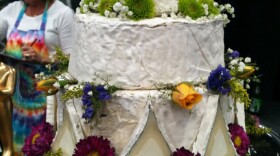In Italy tonight, everyone's having the same thing for dinner, and there's no doubt that it's going to smell terrific.
Forbes magazine food and travel writer Larry Olmsted tells NPR's Jacki Lyden that it's Parmigiano-Reggiano night in Italy. It's all about the cheese ŌĆö and not that stuff you buy in the green plastic canister ŌĆö but the real stuff, made in the country's world-famous Emilia-Romagna region, in the city of Parma.
Using social media and other methods to spread the word, Parmigiano-Reggiano promoters are "trying to get people all throughout Italy to eat the same meal at the same time, sort of a virtual, national sit-down dinner in people's own homes, and to a lesser extent, restaurants," says Olmsted. They're calling it the biggest Italian dinner in history.
Organizers say the dinner is designed to the revitalization of the Parma region. Cheese producers there are still struggling because earlier this year, a series of earthquakes containing millions of dollars worth of the cheese, aged for two years in giant, five-story buildings.
Looking at the warehouses before the quake, you'd see "nothing but cheese as far as the eye can see." Olmsted tells Lyden. "And the wheels are huge, like tires. They weigh 80-something pounds. Several hundred thousand of wheels of cheese fell off the shelves during the earthquake. So, long story short ŌĆö a lot of cheese hit the floor."
But it's not just cheese the region is famous for.
"All the good stuff comes from Parma," Olmsted says. Prosciutto di Parma. Two of Europe's largest food producers, agri-giant Parmalat and Barilla, are there. And Modena, next to Parma, is the epicenter of the gourmet vinegar trade, where Aceto Balsamico Tradizionale di Modena is made.
"If there is an Italian product you would go to a gourmet store to buy, there is a high likelihood it comes from Emilia-Romagna," Olmsted . "But the key is the cheese ŌĆö the king of cheese."
Now there's a new push to make sure it's hitting the saucepan ŌĆö thanks to world-famous Italian chef Massimo Bottura of the highly rated restaurant in Modena.
Bottura developed the recipe Italians will be serving tonight, using that world-famous cheese. It's called cacio e pepe, pasta with cheese and pepper ŌĆö but there's a twist.
Olmsted says Bottura "switched out the pasta for a risotto because northern Italy is rice-based rather than pasta-based. And then he switched the cheese, which would normally be a local Roman cheese. He substituted the Parmiganio-Regginao to sort of tie the whole country together in this one fairly simple dish."
"To me, it's the iconic cheese of the Italian cuisine," Bottura himself told NPR. "I believe in this. I believe in tradition. I believe in quality of the food you eat."
According to Olmsted, hundreds of thousands of Italians are expected to take part in tonight's dinner.
If you'd like a seat at the table, Chef Bottura shared with us a copy of his risotto recipe, below.
Risotto Cacio e Pepe
1/2 pounds Parmigiano-Reggiano, aged for 30 months
4 quarts still mineral water
17.5 ounces Vialone Nano or other arborio rice
1 tablespoon extra-virgin olive oil
1 teaspoon white peppercorns
1 teaspoon Szechuan or black peppercorns
1 teaspoon long Jamaican peppercorns
1 teaspoon Sarawak peppercorns
Parmigiano-Reggiano water, made 24 hours ahead
To make the Parmigiano-Reggiano water: Grate the cheese and mix with the room-temperature mineral water in a large pan.
On the stovetop, slowly heat the water until the Parmigiano-Reggiano starts to form threads at the bottom. A thermometer will read between 176 and 194 degrees Fahrenheit. Remove the pan from the heat and let it to cool to room temperature. Cover with plastic wrap and leave overnight in the fridge.
The next day, take the solid part that has formed on the top and place it in a bowl. This will be used to cream the risotto. Strain remaining solid part to collect the Parmigiano-Reggiano water. Cut the solid part into thin slices and cook in the microwave for a couple of seconds. This is tasty with crackers!
To make the risotto: Over low heat, simmer Parmigiano-Reggiano water in a pot. Put the olive oil in a heavy-bottomed pan. Add the rice and toast until it starts to warm up.
Wet the rice with the Parmigiano-Reggiano water. Stir and continue cooking, adding liquid as you would with any risotto. About three-quarters of the way through cooking, add a little bit of the solids that separated from the Parmigiano-Reggiano water.
When the rice is ready, in 30-35 minutes, remove the pan from the heat and briskly mix in the remainder of cheese to give the risotto a creamy texture.
Crack the pepper individually and grind the Jamaican pepper. Spread the risotto out on a plate and sprinkle generously with the various types of pepper. Serves 4.
Copyright 2020 NPR. To see more, visit https://www.npr.org. 9(MDAxNDQ2NDAxMDEyNzU2NzM2ODA3ZGI1ZA001))





